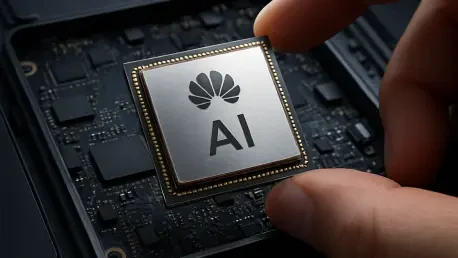In a world where artificial intelligence is reshaping every facet of life, from medical diagnostics to financial forecasting, one staggering fact stands out: the global demand for computing power doubles roughly every 18 months, sparking a fierce race among tech giants to deliver the next breakthrough. At the forefront of this battle, Huawei has unveiled a game-changing arsenal of technologies at Huawei Connect in Shanghai, showcasing its Ascend chip series and monumental SuperClusters. This isn’t just a product launch; it’s a seismic shift in the quest for AI dominance. What does it take to lead this revolution, and can Huawei redefine the future of high-performance computing?
Why Huawei’s AI Ambitions Demand Attention
Amid a backdrop of semiconductor shortages and geopolitical tensions, Huawei’s latest moves signal a critical turning point for the AI industry. The company is not merely responding to challenges; it is aiming to rewrite the rules of technological leadership. With industries worldwide hungry for faster, more efficient AI solutions, Huawei’s innovations could bridge critical gaps in accessibility and performance. This matters profoundly for businesses scaling AI applications and researchers pushing the boundaries of machine learning.
The significance extends beyond technical specs. Huawei’s strategy addresses a pressing global need for resilient computing infrastructure, especially in regions facing trade barriers. By focusing on scalable systems and open collaboration, the company positions itself as a potential catalyst for democratizing AI power, making this moment pivotal for stakeholders across the tech ecosystem.
Decoding the Power of Ascend Chips
At the heart of Huawei’s vision lies the Ascend chip series, a lineup designed to shatter performance benchmarks. The Ascend 950, set to debut next year, boasts an impressive 2 petaflops of computing power at FP8 precision, tailored for the most demanding AI models. Subsequent releases, the Ascend 960 and 970, planned through 2027, aim even higher, with the latter targeting 8 petaflops at FP4 precision and a staggering 4 terabytes per second interconnect bandwidth.
These chips are not just about raw numbers; they represent a direct challenge to industry giants. Built to handle complex neural networks with unprecedented efficiency, they could redefine how AI training and inference are conducted on a massive scale. For enterprises grappling with computational bottlenecks, this series promises a lifeline to accelerate innovation without prohibitive costs.
SuperPods and SuperClusters: Scaling New Heights
Beyond individual chips, Huawei is reimagining computing infrastructure with its SuperPods and SuperClusters. The Atlas 950 SuperPod, rolling out in late 2026, claims to surpass competitors like Nvidia’s NVL144 systems in neural processing unit density and power. This integrated solution targets hyperscalers needing vast resources for AI workloads, offering a glimpse into a future of seamless scalability.
Looking further, the Atlas 960 SuperCluster, expected in 2027, pushes boundaries with over a million neural processing units and 4 zettaflops of computing power in a single instance. Such scale is unheard of, catering to research institutions and tech giants tackling problems once deemed unsolvable. These clusters aren’t just tools; they are ecosystems designed to power the next era of discovery.
Kunpeng 950: A Versatile Computing Force
Huawei’s ambitions extend beyond AI-specific hardware with the Kunpeng 950 processors, launching early next year. Featuring up to 192 cores, these chips power the TaiShan 950 SuperPod, marketed as the world’s first general-purpose computing SuperPod. This versatility addresses diverse needs, from cloud computing to database management, ensuring broad applicability.
This move signals Huawei’s intent to capture a wider market, supporting organizations with mixed workloads. Unlike purely AI-focused solutions, the Kunpeng line offers a flexible foundation for industries not yet fully immersed in machine learning but still requiring robust computational strength. It’s a strategic play to broaden the company’s footprint in enterprise tech.
Open-Source as a Strategic Edge
Breaking from the industry norm of closed ecosystems, Huawei is embracing open-source innovation with initiatives like the UnifiedBus 2.0 connectivity protocol and AI models such as openPangu. Already deployed in systems like the Atlas 900 A3 SuperPod, which has over 300 installations globally, UnifiedBus 2.0 enhances interconnectivity and scalability across clusters.
This openness isn’t just altruism; it’s a calculated effort to foster collaboration and accelerate adoption. By reducing proprietary barriers, Huawei invites developers and companies to build on its platforms, potentially creating a ripple effect of innovation. In a field often marked by exclusivity, this approach could redefine competitive dynamics and spur faster global progress.
Voices from the Trenches
During the Huawei Connect event, Eric Xu, deputy chair of Huawei’s board, offered a candid perspective on the company’s challenges and strengths. “Despite hardware limitations due to trade embargoes, China’s edge lies in superior infrastructure design and a commitment to openness,” Xu stated, highlighting a focus on systemic solutions over isolated components. This honesty underscores the real-world hurdles Huawei navigates.
Industry experts echo this sentiment, noting that scalable, interconnected systems are the future of AI. The global deployment of Huawei’s existing technologies, like the Atlas 900 A3, provides tangible evidence of their potential. With tech leaders increasingly prioritizing integration over raw power, Huawei’s direction aligns closely with emerging consensus, lending weight to its bold claims.
Seizing the Opportunities Ahead
For businesses and innovators, Huawei’s advancements open doors to transformative possibilities. Adopting scalable solutions like the Atlas 950 SuperPod, due next year, allows companies to pilot massive AI training projects at potentially lower costs than rival offerings. Early engagement with these clusters positions enterprises at the cutting edge of efficiency.
Leveraging open-source tools such as UnifiedBus 2.0 enables developers to craft interoperable systems, reducing reliance on locked-in platforms. Meanwhile, integrating Kunpeng 950-powered solutions offers versatility for varied workloads. Tracking real-world performance metrics post-launch, especially for ambitious targets like the Ascend 970’s 8 petaflops by 2027, helps stakeholders make informed, strategic investments in long-term infrastructure. These steps turn Huawei’s vision into actionable progress for a wide array of users.









